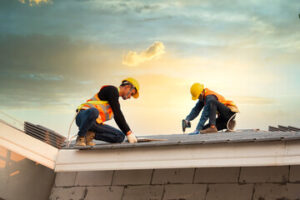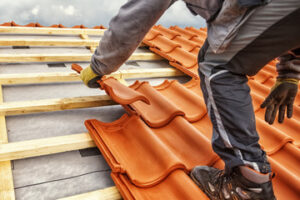Roof Repair Murfreesboro TN involves a comprehensive roof inspection to assess the condition of your roof. This can help identify issues that need to be addressed, such as a sagging roof or moss growth. It can also include additional coatings to enhance water resistance and UV protection.

A leaky roof should be repaired as soon as possible to prevent water infiltration and structural damage. It’s also a sign of worn-out materials or missing shingles, which need to be replaced.
When it comes to repairing or replacing your roof, you must weigh the cost of the materials against the value of protecting your home or business from water damage. Taking the time to understand the factors that affect the cost of Roof Repair can help you make more informed financial decisions that keep your property secure and increase its value.
The type of repairs required can significantly impact overall costs. Quick fixes like addressing leaks or replacing individual shingles are relatively inexpensive and easy for homeowners to do themselves or with minimal professional assistance. Other common repairs include clearing clogged gutters, re-caulking, and re-insulating. These fixes prevent leaks, save energy, and lower your cooling costs.
More extensive repairs can be expensive because they require the replacement of a significant amount of material. These repairs are usually necessary after significant storm damage or when leaks go untreated for a long period of time. Major roof repairs can also involve addressing roof features such as chimneys, skylights, and ventilation systems.
Roofing materials vary in price and durability, with premium materials like wood shakes and slate being more expensive to repair than composite shingles. The size and pitch of your roof will also increase labor and material costs. In addition, your geographic location can influence labor rates and local supply options.
An experienced roofing contractor can assess your roof and recommend the best course of action to address leaks or other issues. Whether your roof needs a minor quick fix, a moderate repair, or a full-day repair, your roofing expert can recommend the right solution to fit your budget.
While a complete roof replacement is an expensive investment, it can be more cost-effective in the long run than ongoing repairs and a potential catastrophic collapse. It also future-proofs your roof against additional storm damage.
The cost of roof repairs can be expensive, but they are an essential part of maintaining your home or business. Regular inspections can catch potential problems early and minimize the cost of a major repair or even a full replacement.
Time
The amount of time it takes to complete roof repair varies greatly and depends on the severity and scope of the issue. Some repairs, such as repairing a few broken shingles, may only take an hour to complete, while other repairs, like fixing a leaky roof or replacing worn out roofing materials, can take days. The weather also plays a factor, as rain and wind can make working on the roof more difficult and slow.
The first step in roof repair is assessing the damage. This includes checking inside the house to look for water spots and stains on the ceilings and walls, as well as walking around the exterior of the home looking for visible damage to the shingles, vents, gutters, chimney, and other features. Once the assessment is completed, the roofers can begin work.
Minor repairs generally take one to five hours to finish. Replacing a few damaged shingles, repairing gutters, and fixing chimney flashing are easy fixes that don’t require extensive labor. More complex issues, such as sagging roofs, repairing leaks, and improving ventilation, are more time-consuming.
Major repairs, such as structural damage and extensive shingle replacements, are often more involved jobs that can take up to a week or more to complete. These jobs require more labor and can be impacted by the discovery of underlying issues, which will then need to be addressed before the roof is finished.
If you’re planning on selling your house soon, a roof replacement is often the best option for long-term value. New roofing materials will look more attractive to potential buyers and will help future-proof your home against harsh weather conditions.
The most important thing to consider when estimating how long it will take to complete roof repair is the contractor’s experience. A reputable contractor should have a wide range of tools and skills, including familiarity with the different types of roofs and their specific materials. They should also have plenty of experience working on homes in your neighborhood and should be able to get the job done quickly and efficiently without disrupting your daily routine.
Materials
The roof is one of the most important components of a home, protecting it from the elements and adding to the property value. However, it is not indestructible and requires a great deal of maintenance to keep it in good condition. Repairing or replacing damaged roofing materials and addressing leaks can prevent serious problems, such as water damage, structural damage, and insect infestation. Regular inspections can also identify potential problem areas, such as cracks or worn-out shingles, and allow you to fix them before they become serious issues.
The materials required for a roof repair project vary depending on the type of roof and the extent of damage. Generally, all repairs should begin with cleaning the roof surface to remove dust and debris, which can interfere with the adhesion of new materials. Then, a roofer should use high-quality caulking or sealant to repair any cracked or damaged areas of the roof. Roofers should also use a waterproof coating to prevent leaks.
Roof repairs can also help improve the energy efficiency of a home. Leaking roofs can cause air to escape, forcing your heating or cooling system to work harder. By repairing leaks and installing insulation, you can save money on your utility bills.
Many people choose wood shakes as a roofing material because of their rustic, natural look and durability. However, these roofs can be damaged by insect infestation and rot. Repairing or replacing damaged shingles and removing rotting wood can help prevent further damage.
In addition to repairing and replacing shingles, roof repairs can include re-sealing the seams of metal roofs and re-bedding damaged tiles. They can also include removing clogged gutters and ensuring proper drainage to prevent ponding water, which can lead to leaks and structural damage.
Inspecting the flashing around chimneys, vents, and skylights is another important part of roof repairs. Flashing is made of sheet metal or plastic and helps to seal the intersections between different parts of the roof. If the flashing is leaking or damaged, it must be replaced promptly to prevent water intrusion. Also, it is important to keep trees trimmed away from the roof to avoid branches that can scrape or puncture the surface.
Insurance
As a homeowner, it’s important to understand what your insurance will and won’t cover when it comes to roof repair. This information can help you make informed decisions about how to best protect your home and belongings.
Generally, homeowners insurance will cover the cost of repairing or replacing your roof when it has been damaged by a covered peril. These perils vary from policy to policy, but usually include environmental or weather-related damage such as hail, storms, and fallen trees. In some cases, the insurance will also cover interior damage caused by a disaster. It is important to note that many policies exclude flood and earthquake damage, so these events may require a separate insurance policy.
In order to file an insurance claim for roof repairs, you must document the damage thoroughly. This can be done by taking photos of the affected area from both inside and outside your house (be sure to use a safe method of getting up on the roof, such as a ladder or scaffolding). In addition, it’s important to note the date and time of the damage, and how it occurred (i.e., falling tree or hail). This documentation will be necessary to file an insurance claim and ensure you receive the proper compensation.
If you have replacement cost coverage, your insurer will replace the damaged areas with new materials at today’s prices. This is an excellent option for homeowners looking for predictability and lower premiums. However, it’s important to note that replacement cost coverage typically does not cover general wear and tear or neglect (i.e., failing to keep up with maintenance).
While some people will try to take advantage of the situation by faking damage or falsifying documentation, this is illegal and can lead to denial of your claim. Choosing a trustworthy and reputable roofing contractor who has experience with insurance claims will help you navigate this process successfully.
If you have any questions about roof repair or insurance coverage, feel free to reach out to our team of experts. We are happy to walk you through the ins and outs of your homeowner’s insurance policy to ensure that you have a full understanding of what your protections are.
